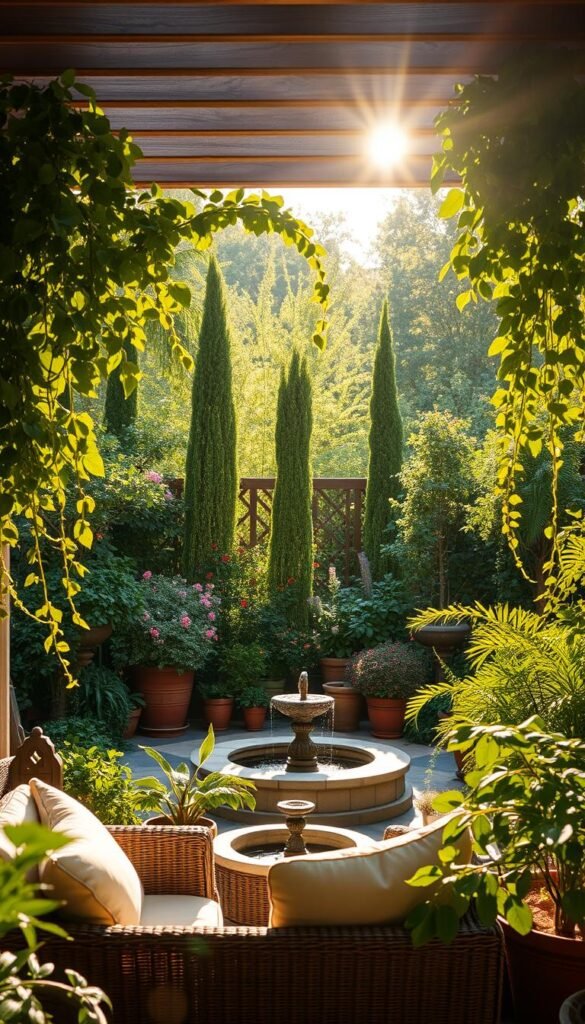In today’s busy world, finding moments to breathe feels like a luxury. The rustle of leaves, the scent of blooming flowers, or the warmth of sunlight on your skin—these simple joys often get lost in the noise. Yet your outdoor space holds the key to reclaiming that connection with nature.
Urban living doesn’t have to mean sacrificing tranquility. With thoughtful planning, even a compact area can become a retreat that soothes your mind and body. Imagine a place where stress fades, replaced by the gentle hum of life thriving around you.
Modern solutions blend beauty with practicality. Durable materials like teak or weather-resistant fabrics ensure longevity, while native plants reduce upkeep. For inspiration on elevating your space, consider layering textures or adding solar-powered accents for evening charm.
This guide will show you how to craft a sanctuary that mirrors your needs. Whether through vertical greenery or cozy seating nooks, every choice nurtures your bond with the natural world. Your journey to a revitalized haven starts here.
The Transformation of Outdoor Living into Personal Sanctuaries
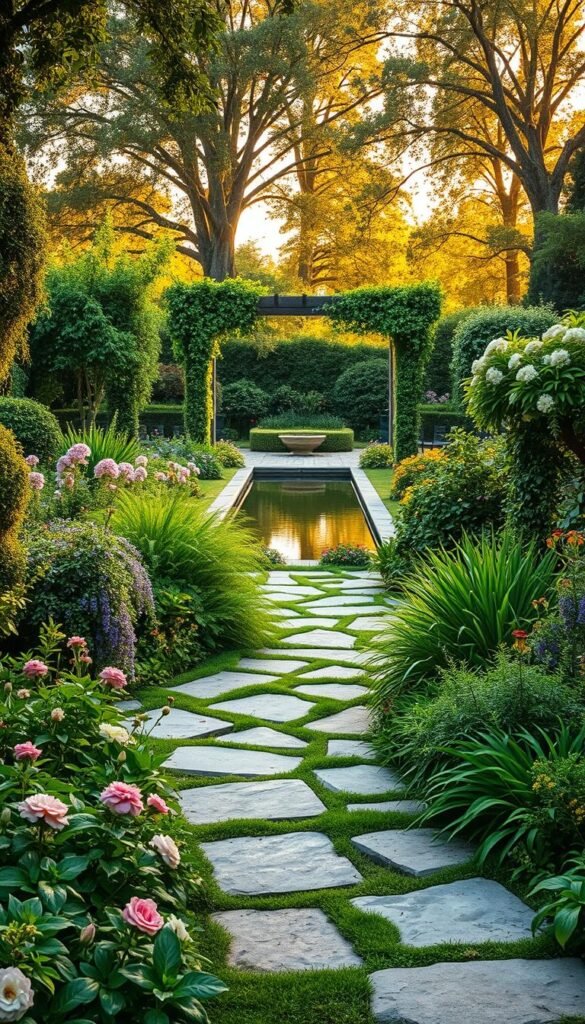
The journey of outdoor spaces mirrors our shifting priorities across centuries. What began as practical plots for survival now serves as extensions of our homes—and souls.
Roots in Ancient Innovation
Early civilizations blended utility with artistry. The Hanging Gardens of Babylon showcased engineering marvels alongside lush greenery. Japanese Zen gardens turned raked gravel into meditative art. These weren’t just plots—they were statements about humanity’s bond with the natural world.
Bridging Past and Present
Renaissance designers left a lasting mark with geometric symmetry. Think boxwood hedges framing stone pathways. Today’s spaces borrow this balance but add smart irrigation or recycled materials. A 2023 National Gardening Survey found 55% of Americans prioritize eco-friendly features—proof that timeless beauty now partners with sustainability.
Mid-century suburban expansions made patios social hubs. Now, they’re retreats from screen fatigue. Your choices—like native plants or solar lighting—carry forward history’s lessons while nurturing your well-being. Every cushion arrangement or water feature becomes part of this living legacy.
Embracing Nature in Your Outdoor Space
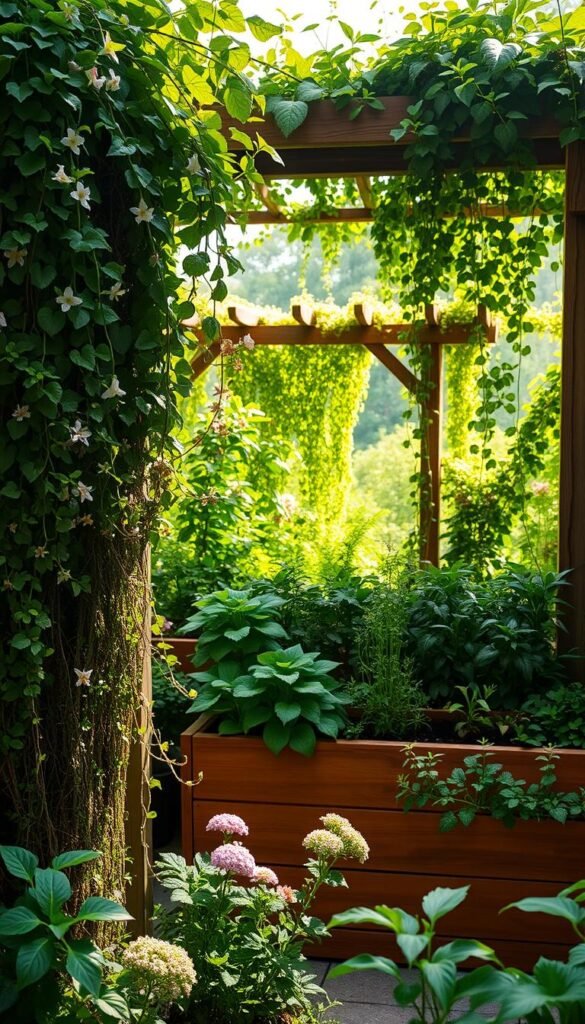
Your backyard holds untapped potential to become a living tapestry of textures and life. By blending earth-friendly materials with thoughtful greenery, you craft more than a layout—you create relationships between species, seasons, and senses.
Earth-Conscious Foundations
Start with materials that give back. Recycled composite decking withstands weather while keeping plastic out of landfills. Permeable pavers let rainwater nourish soil instead of overwhelming drains. These choices shrink your environmental footprint without sacrificing style.
Native species form the backbone of a thriving ecosystem. Black-eyed Susans feed butterflies, while oakleaf hydrangeas shelter hummingbirds. Aromatic herbs like mint and thyme pull double duty—their scent delights you while their blooms feed bees. For fairytale vibes, mix feathery grasses with velvety lamb’s ear.
Smart Greenery Choices
Prioritize plants that work smarter, not harder. Drought-resistant sedum thrives with minimal watering, and ornamental grasses sway beautifully without constant pruning. Layer heights and bloom times: spring bulbs under summer lilies, framed by autumn-blooming asters.
Add rough-hewn logs as natural benches or stack flat stones for casual pathways. These raw elements ground your space in authenticity. When evening falls, solar-powered lanterns cast soft glows on silvery sage and crimson coneflowers—proof that practicality and poetry can coexist.
Patio Garden Design Tips: Turning Outdoor Living Spaces into Green Sanctuaries
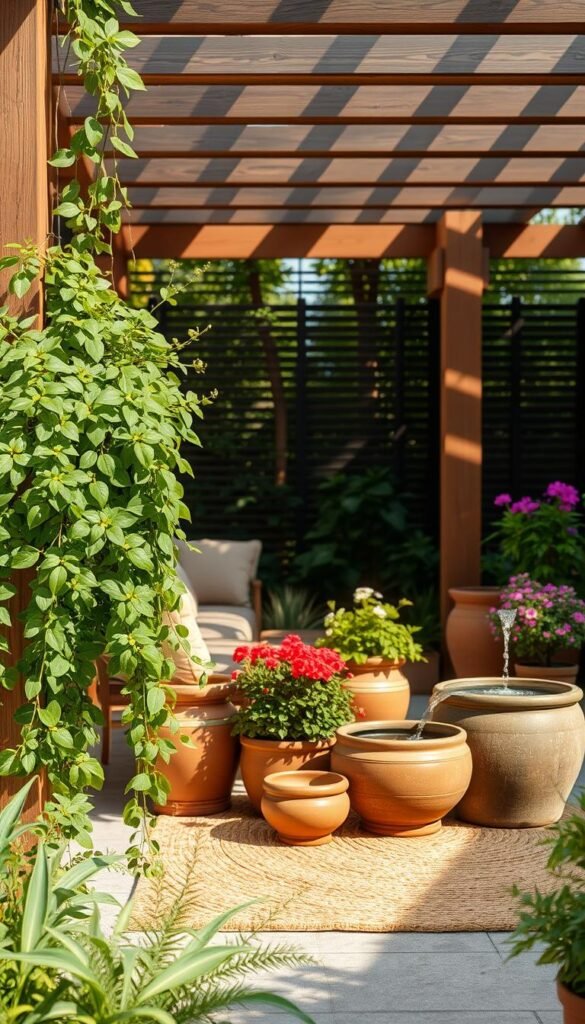
Crafting a serene retreat starts with smart layout choices. Think of your area as a puzzle where each piece—like seating or greenery—serves both purpose and beauty. Balance openness with intimacy by defining zones for dining, lounging, or quiet reflection.
Blending Functionality with Aesthetic Harmony
Strategic tree placement makes all the difference. Position screening varieties like ‘Shishigashira’ Japanese maple along edges to filter sunlight without crowding smaller plants. These compact trees offer delicate shade patterns, letting you enjoy afternoon tea without harsh glare.
| Tree Type | Shade Style | Seasonal Appeal | Mature Height |
|---|---|---|---|
| Japanese Maple | Dappled | Fall color | 8-12 ft |
| California Lilac | Filtered | Spring blooms | 6-10 ft |
For strategic backyard sanctuary tips, pair these with low-maintenance perennials like sedum or lavender. Their textures pop when viewed up close, creating layers of visual interest.
Choosing the Right Elements: Water Features, Lighting, and Furniture
A small fountain or pond adds calming sounds while masking street noise. Solar-powered lights along pathways extend evening use, casting soft glows on ornamental grasses.
Opt for furniture that weathers storms gracefully—teak benches or powder-coated metal chairs. Add weatherproof cushions in earthy tones to tie everything together. Storage benches keep throws or tools handy yet hidden.
Remember: your choices should evolve with the seasons. Modular seating lets you rearrange for summer gatherings or cozy winter fireside chats. Every detail nurtures both practicality and peace.
Designing a Wellness and Therapeutic Outdoor Sanctuary
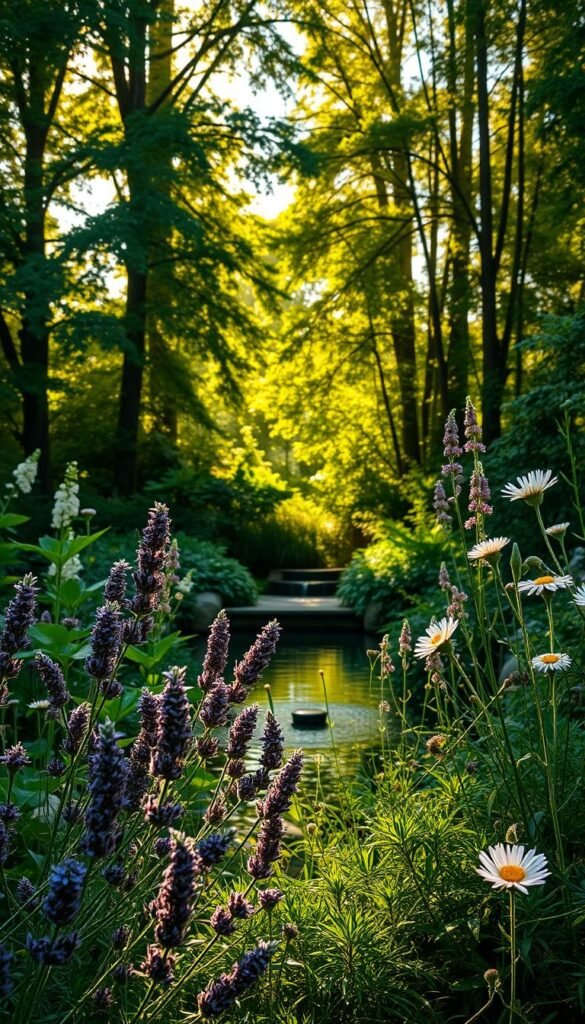
Your surroundings shape your well-being more than you might realize. A thoughtfully arranged sanctuary offers more than visual appeal—it becomes a partner in your health journey. Research shows spending time among plants lowers cortisol levels by up to 16%, proving nature’s role in combating modern stress.
Cultivating a Healing Environment Through Thoughtful Planting
Choose greenery that works double duty. Lavender’s purple spikes calm nerves while repelling mosquitoes. Mint invigorates senses and flavors your iced tea. Cluster these near seating areas where their scents can work their magic.
Prioritize textures that engage touch—velvety lamb’s ear leaves or crinkly ornamental grasses. A 2023 University of Michigan study found tactile interactions with foliage increase dopamine production by 29%. Pair these with edible blooms like nasturtiums for snacks while you weed.
Creating Spaces for Mindfulness and Relaxation
Carve out a meditation nook using curved benches facing a bubbling fountain. The sound of moving water masks traffic noise while encouraging deep breathing. Add a reclaimed wood planter box of chamomile—its apple-like fragrance enhances relaxation.
Morning sun patches make ideal spots for yoga mats. Frame them with bamboo screens for privacy without blocking light. Come evening, hang string lights above your reading chair—their soft glow helps transition from day to dusk peacefully.
Remember: every rake stroke or watering session counts as exercise. Thirty minutes of gardening burns 150 calories while improving grip strength. Your retreat isn’t just a place—it’s an active contributor to your vitality.
Innovative Ideas for a Multi-Sensory Garden Experience
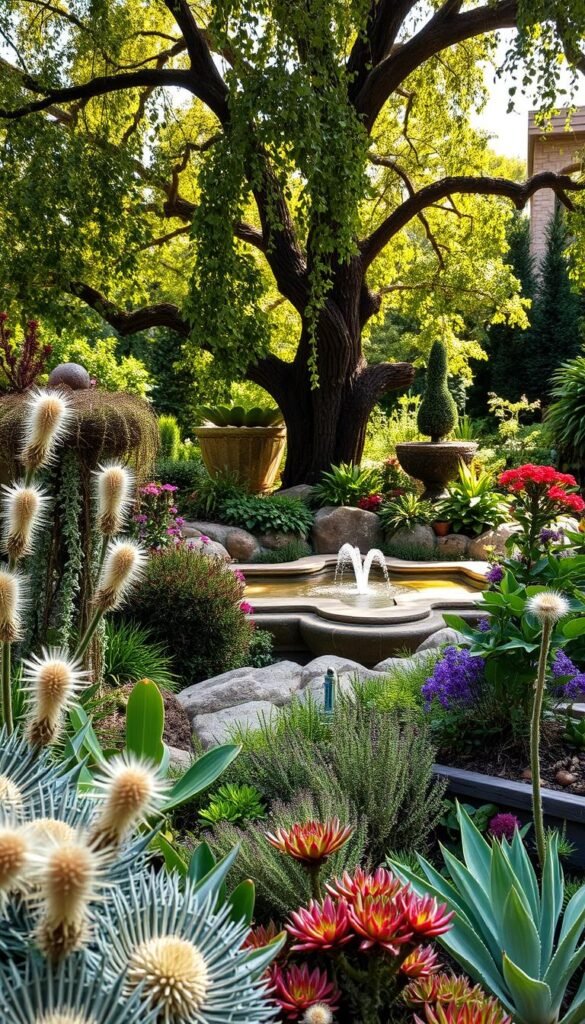
Your environment becomes an orchestra of sensations when you engage sight, smell, and sound together. This approach transforms ordinary corners into immersive escapes that refresh both body and mind.
Crafting Atmosphere Through Strategic Elements
Cool blues and soft pinks in hydrangeas or astilbes create calming zones near seating areas. For vibrant energy, cluster marigolds or sunflowers in sunny spots. These colors influence mood subtly but powerfully—a 2023 Rutgers study found yellow blooms boost serotonin levels by 23%.
Layer scents where movement happens. Plant rosemary along walkways so brushing releases its piney aroma. Star jasmine climbing trellises perfumes evening air naturally. Pair these with mint or lemon balm in pots—their scent lingers on your hands after pruning.
Ornamental grasses like maidenhair or fountain varieties add whispery sounds as breezes pass. Combine them with bamboo wind chimes for layered acoustics. A small bubbler tucked among flowers masks urban noise while attracting thirsty birds.
Mix textures for tactile intrigue. Velvety lamb’s ear leaves contrast with spiky yucca or smooth river stones. This variety invites touch, deepening your connection to the space.
For summer resilience, choose lantana and sage—they thrive in heat while keeping colors vivid. Create dedicated zones: a lavender-lined path for aroma therapy, a textured succulent wall for fingertips, and a goldenrod patch buzzing with pollinators.
Bringing It All Together: Your Journey to an Inviting Outdoor Retreat
Your journey to create a personal haven begins with small, intentional choices. Start by observing how sunlight dances across your space at different hours. This helps you position seating areas for morning coffee or evening stargazing sessions.
Incorporate elements that spark joy year-round. A compact bubbling fountain adds soothing sounds while supporting local birds. Pair it with native plants like coneflowers, which thrive with minimal care and attract pollinators. For those working with limited room, try maximizing every inch of your yard using vertical planters or foldable furniture.
Choose materials that age gracefully—weather-resistant wicker or stone pavers develop character over time. Add softness with throw pillows in earthy hues, creating instant relaxation zones. Remember, your retreat evolves with you. Swap summer annuals for frost-resistant kale in autumn, keeping colors vibrant.
Ultimately, your sanctuary becomes a reflection of what rejuvenates you. Whether it’s the crunch of gravel underfoot or the whisper of ornamental grasses, these details stitch together a place where stress dissolves. Your efforts today plant seeds for countless moments of peace tomorrow.

